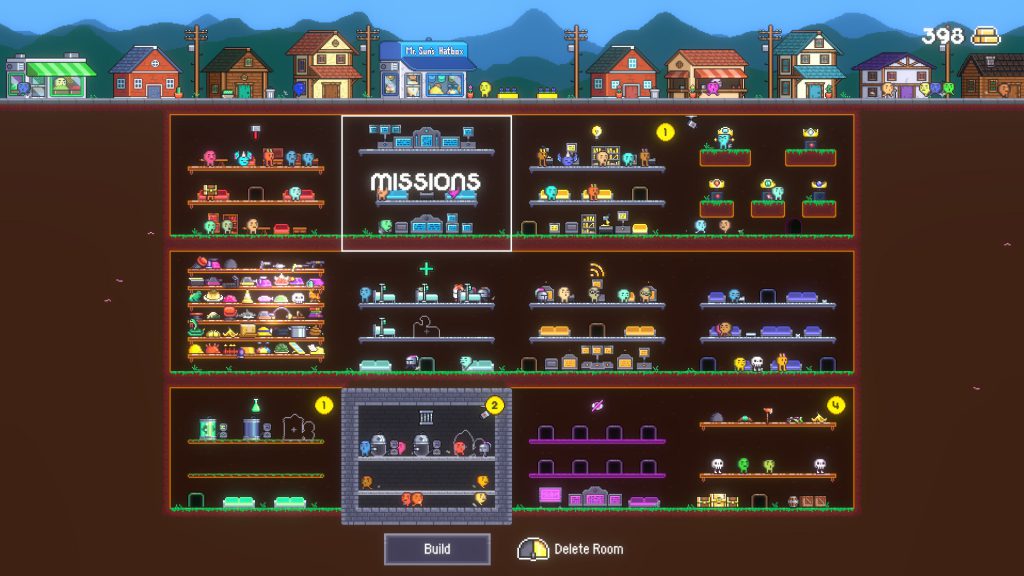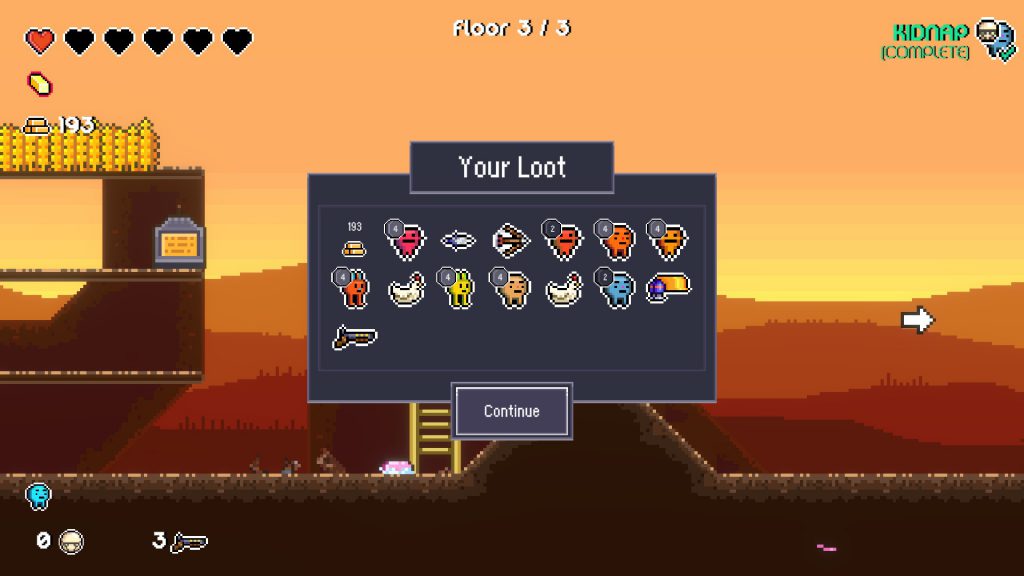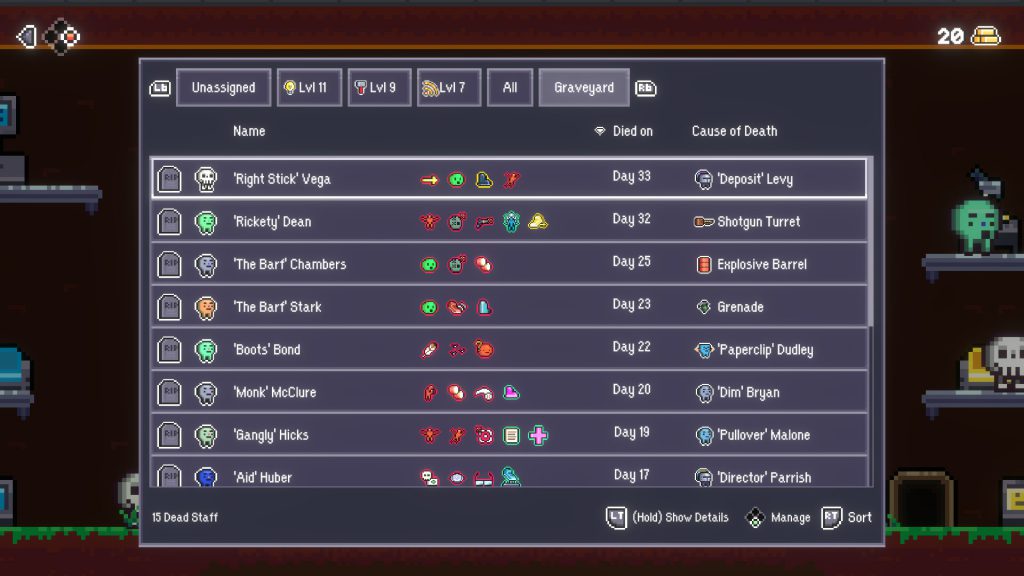Mr Sun’s Hatbox is Tactical Espionage Action at its quirkiest and best
There aren’t many stealth games out there, and one reason for that is that it’s incredibly hard to balance what happens when stealth goes wrong. You’ve got to give your enemies the same brutal power that you have over them, and you need to be against the odds. Mr Sun’s Hatbox is a great stealth game because it finds that balance perfectly. It’s also goofy fun.
Overflowing variable lists have given games a lot of amazing things over the years, and a lot of people would agree that colony sims, for one, are vastly better because of the chaos that comes from two dozen traits and factors being pulled semi-randomly from an incredibly long a lot of options. Mr Sun’s Hatbox leans into that, as many roguelikes do, but it takes the familiar Metal Gear Solid V: The Phantom Pain ‘Mother Base’ formula, and funky stealth, and bolts in a fantastic quirk system alongside stacks upon stacks of items. Does this mean you’ll be carefully committing somewhat useful soldiers to tasks like research and sales? Yes. But, it also means that you’ll be selling Rubber Ducks and slippery bananas for profit all while rescuing people with names like “Gangly” Hicks and “The Barf” Chambers using MGS style Parachute capture devices.
The story here is so simple it’s non-existent, but maybe irrelevant and irreverent is the better description. Mr Sun has ordered a parcel, and suddenly Mr Moon sweeps in and steals it. The delivery driver reassures Mr Sun that they will definitely get back his parcel, and so set up a multi-level, high-security base in and around the basement of Mr Sun’s Hat Shop. From there the story is only really referenced when you recover a magical hat — these serve as the chaptering and ‘world’ ends within your lengthy quest to return the parcel, and they also gate off certain base upgrades. That’s it, discussion of the story is out of the way.
Right from the first mission through to your final one, there’s always a sense of unpredictability, be that due to traps, enemy density or the items that’ll be around. You’ll also contend with things like security cameras and turrets as the campaign continues, as well as an increasing variety of hats and other dangers. And that makes things like loadouts, backup minions, supply drops and quirks incredibly important as you move through the campaign. There’s nothing more crushing than losing one of your highest level minions, with all of their positive quirks, because of a misstep on a mission, but that kind of thing is exactly what will happen if you allow yourself to get overconfident.
 Even though it’s on a 2D plane, there’s a lot of room in each of the levels, and that — combined with the previously mentioned dangers — means that there are a lot of ways that overconfidence can come through. Your units won’t heal between missions unless you put them in a medical bed to rest, so not reading your new character’s quirks might mean that you make a foolish mistake like snapping the neck of an opponent when squeamish (causing you to collapse to the ground) or not being immune to traps; or having a hatred of guns (so they break after one shot) or the ability which allows you to kill an enemy by dropping on them. A shift like any of those, and dozens more, are enough to turn your successful run of a dozen, bloodless days into a massacre as you have to adjust strategy. In that way it feels very much like Rogue Legacy, which features a similar flip-of-the-coin quirk system, albeit these almost come together like a cocktail — you can get some really interesting combinations as your characters level up and gain more quirks.
Even though it’s on a 2D plane, there’s a lot of room in each of the levels, and that — combined with the previously mentioned dangers — means that there are a lot of ways that overconfidence can come through. Your units won’t heal between missions unless you put them in a medical bed to rest, so not reading your new character’s quirks might mean that you make a foolish mistake like snapping the neck of an opponent when squeamish (causing you to collapse to the ground) or not being immune to traps; or having a hatred of guns (so they break after one shot) or the ability which allows you to kill an enemy by dropping on them. A shift like any of those, and dozens more, are enough to turn your successful run of a dozen, bloodless days into a massacre as you have to adjust strategy. In that way it feels very much like Rogue Legacy, which features a similar flip-of-the-coin quirk system, albeit these almost come together like a cocktail — you can get some really interesting combinations as your characters level up and gain more quirks.
But, when they level up they can also lose quirks (normally negative) and gain maximum health increases — adding even more value to that character and making it even harder when you lose them. Levelling up also only happens through running missions, so it’s a constant risk-reward situation, and while you do later get the chance to tweak minion quirks through a Lab building, that won’t increase level or maximum health.

It’s the great wealth of choices that makes Mr Sun’s Hatbox stand out though. While it’s a stealth game at its core, and it will give you bonus XP for not killing enemies or setting off alarms, it completely excels during chaos. There have been so many moments where I’ve dropped into a situation, done something incredibly stupid and then, about 20 seconds later, been standing over a massive stack of unconscious or dead enemies. It completely captures that feeling when things go wrong and then right in great ‘stealth’ games like Hitman, Heat Signature and MGS. Those moments when a turret or a bad shot from an enemy saves your life, and those moments where there’s just one enemy before the exit door and you’re unarmed on one health, then it turns out they have the Coward quirk and just run away from you… Those moments make the game. But, there’s a very simple reason why all of this feels like a choice, and so it feels like you’re making the right (or wrong choices) and that’s the restriction on what your character can carry.
You can’t deploy with eight guns and a series of hats; You have to either procure on-site or are restricted to just one hat and weapon and that each weapon only has limited uses or ammo. Considering that, especially at the start of the game, you’re going in blind beyond your objective (Rescue X, Steal X, Deliver X, Kill X, Capture X) and a vague difficulty rating, it makes everything feel dynamic and essential. Why would you take a baguette or banana from the floor as a weapon or a hat? It’s because you need to have something more than just the power to (potentially) knock people out by jumping on their head and (potentially) snap people’s necks or parachute-capture them while they’re down.

Anyway, I’m in danger of chatting about Mr Sun’s Hatbox forever, but there are a few more things that I want to squeeze in here before I wrap up this article. 1) If you take a picture with a camera item in the game it puts a little picture in a folder on your computer desktop, that’s so cool. 2) At one point I attached a parachute to a frog, then the frog swallowed me, and that counted as me exiting the mission as a success. 3) Getting double the goodies later because you parachuted the chest out rather than opening it up there and then is a great idea. 4) The necromancy quirk (where you turn into a skeleton instead of dying) is amazing.
The biggest negatives here are actually conflations of how the game is powered: Sometimes you will simply die because there are too many hats, trapping you infinitely in a space, and sometimes an idiot minion will shoot toward you triggering a cascade of exploding barrels that will annihilate everything… ever. As such, maybe its biggest issue is scale.
Mr Sun’s Hatbox works great with its smaller, contained levels, and when your base staffing is kept slim. However, as your base gets bigger the options to filter your staff, assign minions to ‘deployment teams’ and maybe assign markers to them (beyond renaming) means that you need to make a choice between overthinking your actions in the base, or just using the (handy) optimise function to assign tasks to your staff, but then contradict that as you weaken the facilities by plucking out workers to send on missions. It’s a small issue, but the absence of a simple ‘do not assign to other roles’ option is felt, especially with larger bases.
Mr Sun’s Hatbox is a phenomenal game that fans of the stealth and roguelike genres will adore. It’s available now on PC & Mac via Steam.
Comments are closed.